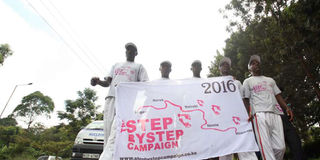DR BOSIRE: The man who took a step to beat cervical cancer

The Step By Step Cervical Cancer Campaign team Peter Chacha,Phillip Rogoro,Nyangi Nyomahanga,Daniel Chogo and Thomas Chacha walking along Waiyaki Way in Nairobi during their 13th Day walk from Migori Town as they head to Mombasa. PHOTO| FILE| NATION
Thomas Chacha may not be a woman, but he understands the pain of watching someone die a slow excruciating death from cervical cancer, having lost loved ones to the dreaded disease.
He has struggled to help dozens, who deteriorated right before his eyes. He has buried far too many women in the few years he has been a cervical cancer prevention advocate.
He has wept with many orphans and widowers who have suffered devastating grief.
I first met Thomas in 2016, when he led a small team of five men who had walked 500 kilometres from Migori to Nairobi to raise awareness about cervical cancer.
The team was haggard, but they elated about their walk to fight cervical cancer.
REAL TROUBLE
Many women do not even know what the cervix is or that they have one, until it is in real trouble.
This little part of the female anatomy, where the babies pass through, separates the lower genital tract from the upper sterile part of the female anatomy, and bears the responsibility of being a gatekeeper.
It keeps micro-organisms within the vaginal canal, denying them access from the uterine cavity and the pelvis at large.
It keeps tightly closed for 40 weeks as the baby grows in the womb.
Yet for all its significance, we only pay attention when it refuses to work. We are overwhelmed when the gate doesn’t stay closed leading to a miscarriage.
We forget to service it by doing regular pap smears and only wake up with a start when it breaks down. Yet we cannot afford the cost of its breakdown.
The physical cost is astronomical. Cervical cancer is unforgiving, relentless and ruthless. It eats the woman up from the inside out in every sense.
From bleeding, to discharging heavy foul-smelling pus ,to weight loss, recurrent infections and pain.
As she suffers physically, the disease also takes an emotional and psychological toll.
REPULSION
One cannot describe what a woman goes through, knowing she is dying and leaving her children orphaned.
It is harrowing to know that the infected, pus-oozing mass makes her smell so bad that even her loved ones struggle to remain close.
That the man who once found her very sexually-attractive is now repulsed by the thought.
The cost of treatment is an even bigger burden, which is why it is not strange to hear that the patient will go back home to die.
It is these women who inspired Thomas to get up and find a way to make a difference.
He realised how important it is to prevent this highly preventable cancer and stem the tide of death.
Through his organisation, Thomas has worked tirelessly to put a human face to the fight against this cancer.
The male face impresses upon all of us that there is no way to win this war without involving everyone.
It was therefore not difficult to imagine how Thomas lit a fire in all of us to do something.
This inspiration gave birth to the Step by Step Cervical Cancer Campaign, a 34-day walk from Migori to Mombasa, traversing 14 counties and covering 1,000 kilometres.
This was a partnership between Smilewoman CBO, Nation Media Group and Swiftmed Solutions, with an aim of raising money to screen women for cervical cancer in Migori County and provide treatment for those who require it.
Despite not meeting the target for fundraising, the walk created massive awareness about cervical cancer, and enabled Thomas to put a smile on the face of the women he tirelessly traversed the country for.
The campaign has put a National Hospital Insurance Fund (NHIF) card in the hands of every cervical cancer patient in Migori County.
Beating cancer is an effort embodied in the campaign, one little step at a time.
Thomas got us this far, we must then not fail him. As we continue to emphasise the importance of screening, we must also look at how to finance that.
My humble suggestion is that if NHIF can afford to treat cancer, it can surely afford to screen the population.
In the long run, this would be the best investment in reducing the overall cost of treatment.



